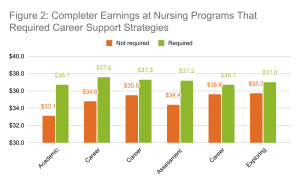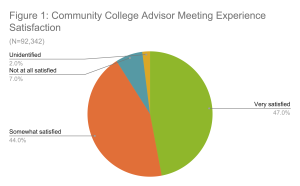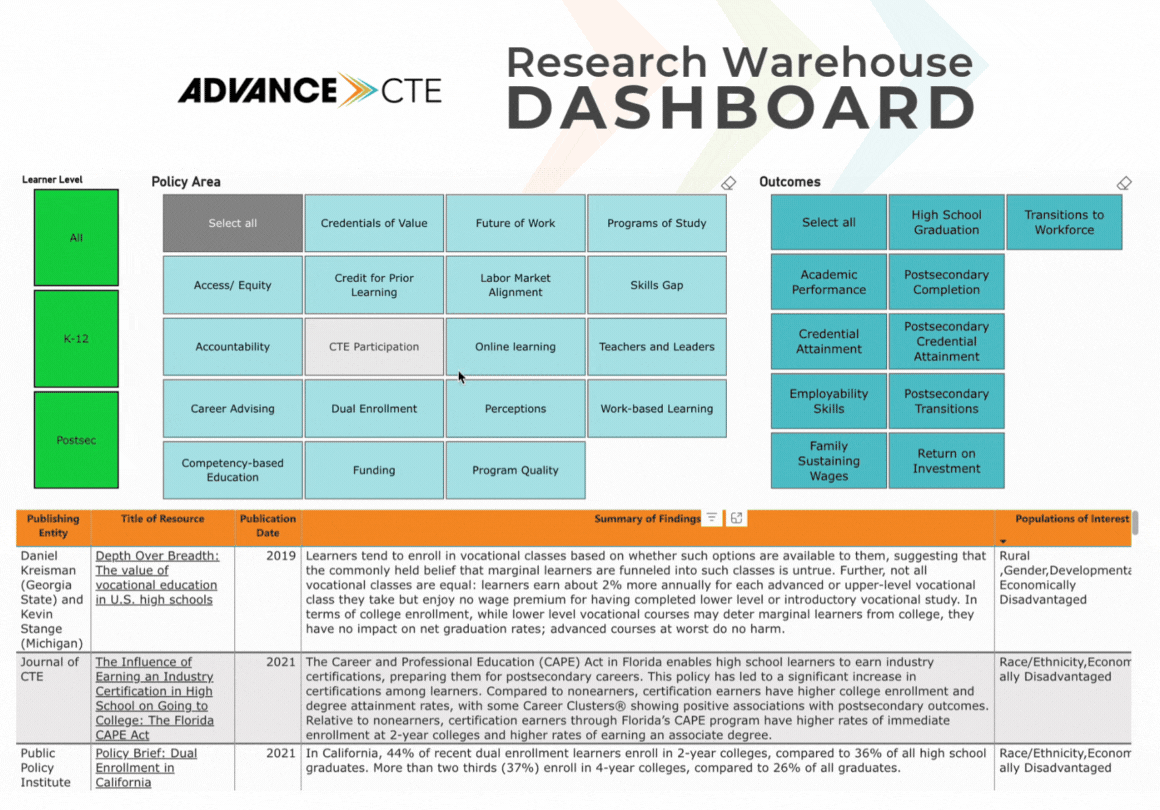Career advising plays a critical role in helping learners navigate and connect their academic and career goals, especially within Career Technical Education (CTE) programs. At the same time, growing evidence is revealing what policies and practices truly work in career advising.
Drawing from six studies featured in Advance CTE’s Research Warehouse Dashboard, this Research Round-Up highlights learner outcomes from postsecondary career advising and system-level models of career services. Together, these bodies of research provide valuable insight for designing career advising structures to better support learner success.
Why Career Advising Matters
Career advising is more than helping learners pick a major or choose their next course–it builds a foundation for success. From setting academic and career goals to connecting them with timely support, effective advising empowers learners to skillfully navigate their career journey. High-quality career advising can help identify employment opportunities, encourage persistence, and build confidence in learners that turns into momentum.
A 2022 survey administered by the National Association of Colleges and Employers found that graduating college seniors who used even one career advising service received more job offers than those who did not, and each additional utilized service further increased their likelihood of receiving an offer. Learners who used career services to find an internship were 2.2 times more likely to land a paid internship than an unpaid one or none at all.
Another report highlighting promising practices and outcomes of effective rural community colleges found that a strong career advising infrastructure ensures learners receive consistent support. A Zane State College case study highlighted how a mandatory first-year experience course and intake survey enabled career advisors to tailor support for learners, especially those identified as at higher risk of not persisting. Following the implementation of this model, the college’s three-year completion rate for first-time, full-time students rose from 34% in the 2012 cohort to 54% four years later.
Research Highlights: Career Advising in Practice
The learner outcomes evidence base for career advising may still be growing, but the existing studies paint a clear picture: high-quality career advising can make a meaningful difference in learner success. Less clear is how consistently learners access that support and how effectively it is being delivered. The following studies provide some insights on learner satisfaction and outcomes from advising.
For example, longitudinal learner data from the Community College Survey of Student Engagement, administered by the Center for Community College Student Engagement (CCCSE), shows that among learners enrolled in a community college for more than one semester, 78% report meeting with an advisor. Figure 1 outlines the experience satisfaction of those learners who attended more than one advising appointment.
Despite this, there has been good progress in creating a more integrated and holistic career advising process that addresses learner needs over time. The same study reports that in 2011, just 56% of first-year students said an advisor helped them set academic goals and make a plan; by 2016, that figure increased to 67%. This trend is encouraging, but underscores the need for continued career advising improvements.
Some colleges have taken up that challenge. The same CCCSE study highlighted that the Community College of Philadelphia introduced a new career advising model in fall 2016 that assigned full-time career advisors to learners in the college’s largest programs (i.e., liberal arts, healthcare, business, etc.). Results from this model were promising: fall-to-fall persistence for first-time learners rose from 45% in 2015-16 to 51% in 2016-17.
Another college, Cleveland State Community College in Tennessee, implemented a similar career advising infrastructure in 2011, and by 2013:
- Its three-year graduation rate had grown from 14% to 22%
- Learners earning 24 credits in their first year rose from 10% to 30% by 2016
- Learner improved–59% of learners in 2014 found advising easy and helpful, and grew to 78% in 2017.
A 2024 quantitative study on community college student-advisor appointments and student success metrics cites the CCCSE report with updated figures to prove career advising’s lasting power further. The study found that students who participated in one career advising appointment had a college persistence rate of 82.1%, compared to just 64.2% for those who did not attend any advising sessions.
While these studies reflect broader postsecondary trends, similar advising strategies have a great impact on postsecondary CTE programs.
In 2021, the Urban Institute examined how academic and career advising strategies functioned in two postsecondary CTE programs: business and nursing. Academic and career counseling in CTE are often intertwined to connect completers with employment opportunities. The Urban Institute found that 80% of nursing and 78% of business learners reported using academic counseling/advising services throughout their program. Additionally, 19% of business learners singled out career counseling or career exploration as the service that needed the most improvement, citing the need to expand career options, hire a dedicated career counselor, and administer an assessment to ensure learners were pursuing the correct degree for their career goals.
On average, nursing programs that required career counseling, academic counseling, or assessment of skills or interests had graduates with slightly higher earnings than programs not requiring those strategies. Figure 2 is adapted to show the earning difference between nursing programs that did and did not require career advising.

Adapted from “Strategies for Workforce Success in Career and Technical Education,” by Nathan Sick et al., 2023, Urban Institute.
A 2018 study evaluation conducted by MDRC assessed three community colleges in Ohio–Cincinnati State Technical and Community College, Cuyahoga Community College, and Lorain County Community College–that adopted the Accelerated Study in Associate Programs (ASAP), a model developed by the City University of New York. Designed to address multiple barriers to learner success, ASAP offers up to three years of financial and academic support. Central to the model is a robust learner support system, with career advising as the strongest and most consistently implemented component. In fact, 95% of participating learners met with an advisor at least once during their first semester, and over 60% had six or more meetings.
Participants were interviewed for the study and credited career advising above all other services for their persistence and success in college.
Top Takeaways from Career Advising Research
Several common themes emerge through the findings that highlight what works and where challenges remain in delivering effective career advising. These findings point to areas where state and local leaders can focus efforts to strengthen career advising infrastructure and expand access to quality guidance for all learners:
- Sustained career advising drives positive learner outcomes
- Embedded and structured advising models are associated with higher learner satisfaction and improved persistence
- Learner satisfaction and access to quality advising are inconsistent
Connect Research to Your Work
Advance CTE continues to track and share evidence-based research related to 18 areas of CTE policy and practice. Explore the Research Warehouse Dashboard to access additional studies on career advising and other key topics.




